9ª Biennial 2009
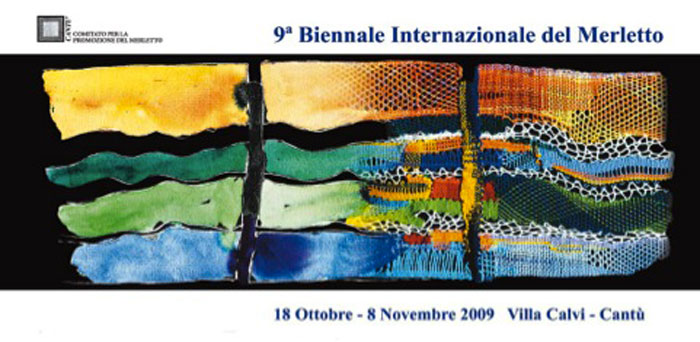
9th INTERNATIONAL LACE BIENNIAL 2009
Cantù 18th October – 8th November 2009
Organised by the Lace Promotion Committee, Cantù
AN EXHIBITION RICH IN HISTORY
The Cantù International Lace Biennial has reached its 9th Edition and the commitment to appreciating and rediscovering this particular sector of artistic-craft production, which has been present since the first event in 1993, continues. During these years the public has been offered the chance to observe and appreciate artefacts never exhibited before, clothing and sacred and profane decoration which were and are created thanks to the technical knowledge and manual skills which have been developed and handed down by generations of Cantù women, from the sixteenth century to today.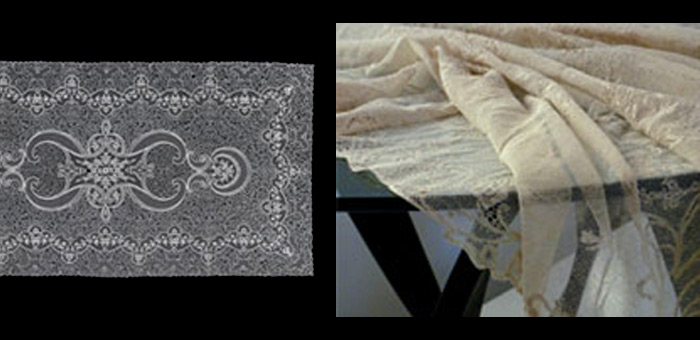 01 Leading lace – Historical section (first floor)
01 Leading lace – Historical section (first floor)Lace and furnishing from the tradition to the dawn of the third millennium.
Lace and furnishing as expression of a common area of application: furnishing and the decoration of the home. Only today, having reached the 9th edition of the Lace Biennial, the organizing Committee desires to tackle a theme which to those not from Cantù might seem a natural, logical step: to highlight the two flourishing activities with which the city of Cantù is associated, lace and furniture.
The exhibition: Our intention is to take advantage of the Biennial to propose a new point of view of these two “arts” and increase the visibility of their combination, admiring unique lace works which placed on valuable furniture give life to new, splendid settings. A unique prestige craft, that of Cantù, which has been able to change with the times, with the new tastes of artists and beauty-lovers and which is well inserted in the all-Italian strand of artistic manufacture. Whether it is artistic flair or classical tradition, or the reinterpretation of this in a contemporary key, the weave of beauty and perfection will be before your eyes for technical, professional and aesthetic judgement.
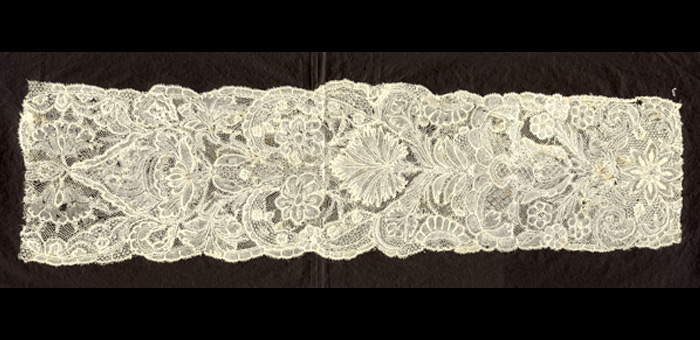 02 Lace from the Collection "Giacinta Romanelli Marone"
02 Lace from the Collection "Giacinta Romanelli Marone"
Historical section (ground floor) curated by Thessy Schoenholzer NicholsGiacinta Romanelli Marone, was Genoese in origin, and a connoisseur of lace and embroidery. In 1902 she published, for the publishing house Hoepli, Milano 'Trina a fuselli in Italia (Bobbin Lace in Italy)'.
Romanelli created a collection of small fragments of all the types of handmade lace and reticella (bobbin, needle lace, reticella, gauze, filet etc). There are about 700 fragments, coming from various areas of production: Flanders, England, Spain, France and especially Italy and of this latter there is evidence from each region, with a predilection for her native Liguria. The lace are sewn carefully onto black or dark red tissue paper and kept in 32 numbered bags and organized according to technique. Romanelli used this collection to teach young girls interested in the subject the design and working of bobbin lace. It is thus a collection to be seen as a portable museum, teaching tool, and inspiration for lacemakers.
The exhibition: This consists of a hundred or so antistatic pads of format about 16.5x11cm with one or more lace items applied to each pad. The fragments represent the most significant techniques of bobbin lace produced from the 16th to the 19th century. A path of intertwining threads which unfolds example after example, covering four hundred years of European production of lace. These artefacts will be exhibited in the cases of the historical section together with details of the international terminology, alongside that in use in the Cantù area, and by beautiful drawings of the most representative pieces (to facilitate reproduction).
Exhibition catalogue: The iconography described above and the introductory essay will be realized by the lace historian Thessy Schoenholzer Nichols of international fame, who has collaborated on other editions of this Biennial.
For the first time the essays in the catalogue will be published in Italian and in English.
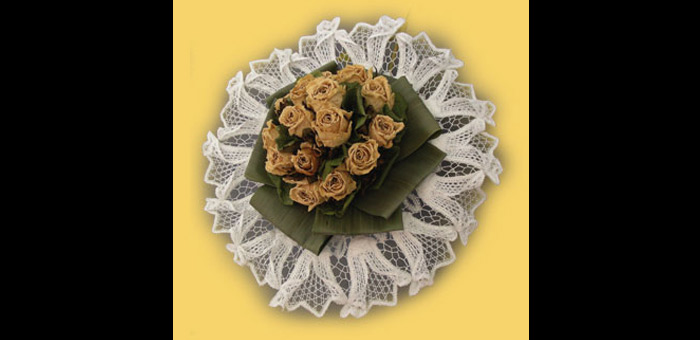 03 Exhibition of lace of contemporary production
03 Exhibition of lace of contemporary production(first floor)
As in previous editions an important sector of the Lace Biennial is dedicated to contemporary production in the Cantù area.The “schools” variously consist of associations, committees, and amateur groups, almost always founded through the personal interest of women who, together with others, decided to share their passion for lace and to improve their knowledge of pillow lace working techniques, which were once handed down orally from one generation of women to the next.
The work spaces which originally consisted of farmhouses have been replaced with different meeting places, spaces offered by the city authorities, parishes or other, but the original idea of collectively sharing experience acquired, works created and ideas to make them into a heritage of common growth is still alive.
The activity of the schools thus offers the most important sign of the vitality of this working technique, precisely because it is fuelled only the passion and generosity of spirit of the lacemakers who dedicate time and energy, taking it away from other opportunities for paid employment or family commitments and moving away from a market or profit. The distance from a professional production aimed at trade has also had the result of a certain freedom in the choice of the lace decoration, this also being entrusted to the taste and the research of the various schools. These researches range between two poles, on one hand you can note the recovery of the most typical Cantù style both in stitches and in motifs, just as it was defined between the nineteen-twenties and sixties, which shows the will to preserve a tradition which otherwise risked disappearance, on the other hand one notices experimentation in the designs and sometimes in the materials, signs of a research which is still alive and in evolution.
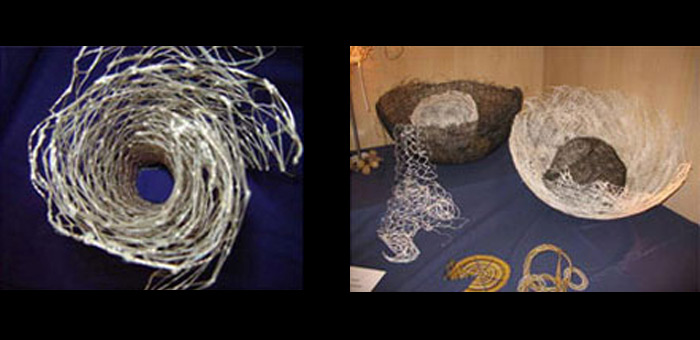 04 Genetically modified lace by Mira Fidanza
04 Genetically modified lace by Mira FidanzaArtists section (ground floor)
At the Permanent Furniture Exhibition, Piazza Garibaldi
Mira Fidanza lives in Locarno and has a great passion for bobbin lace. She experiments with new designs and manages to assemble materials of various origins, arriving at true sculptures. The motto which best represents her? When someone says to you “I know how to do that too” it means they know how to redo it, otherwise they would already have done it.
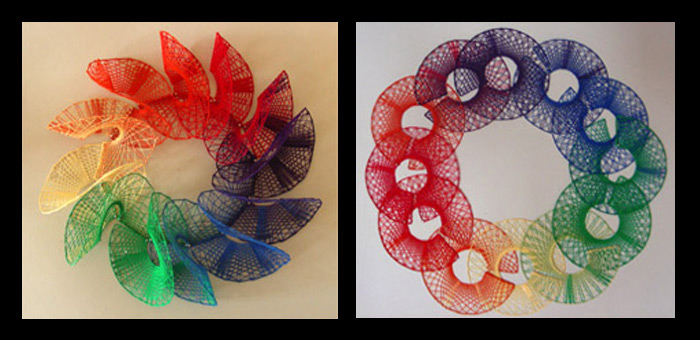 05 Colour theory
05 Colour theoryForeign section (ground floor)
Lace from VSS FDS, Federation of Swiss Lacemakers.
At Villa Calvi, Via Roma 8
Curated by Ruth Bühlmann. The lace works exhibited are the fruit of a convivial experience of some Swiss lacemakers. The excellent matches derive from the knowledge of colours, shapes and structures, applied to the basic technique of bobbin lace. A good choice among colours, patterns and contrasts makes the difference between harmony and chaos.
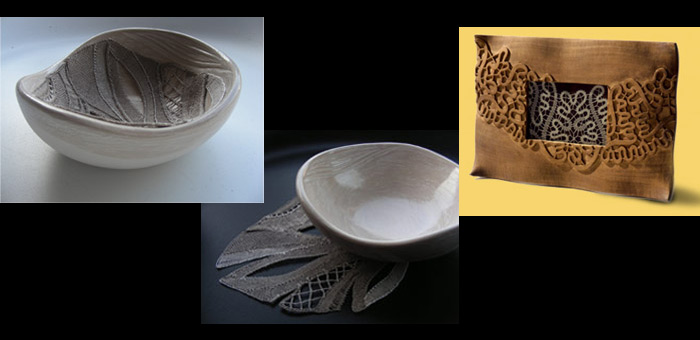 06 Intaglio lace
06 Intaglio laceArtists section (ground floor)
Renata Casartelli Studio
Renata Casartelli works in artistic crafts in the area of frames and lace.
She has collaborated for many years with the Lace Promotion Committee, the association which organizes the International Lace Biennial in Cantù.
She is the owner of Atelier Perlarte www.perlarte.com which was set up with the objective of giving a new impulse to the activity of the artist-craftswoman, meeting the need to appreciate and conserve antiques and works of art or design, and designing and producing articles characterised by essential lines, precious finishing and natural materials.
- From Cluny to Cantù
A long tradition says that the ancient art of pillow lace with bobbins was introduced to Cantù by the Benedictine Nuns of Cluny, but documentary evidence is lacking.
In his monograph on “Cantù in the history of lace” (Como, 1988) Salvatore Dell'Oca publishes the reproduction of a shirt cuff in “cloth stitch” dateable towards the end of the seventeenth century and formerly in St Theodore’s Church. In any case some documents preserved in the Milan Diocesan Archive prove the existence in Cantù, at the Convents of St Ambrose and St Clare at the date of 1688 of two convent schoolgirls. It is possible that these pupils were taught lace techniques.
These and other documents prove the existence in Cantù of ancient traditions in the art of lace which then underwent remarkable development in the work of the late eighteenth century and of last century, but the state of the sources before the seventeenth century is not what could be desired and nothing certain may be said on this topic.
Lacemaking, recognized as of very high quality technically and aesthetically has occupied entire generations of women constituting an integration of family income.
(from the of Cantù City Council website - www.comune.cantu.co.it)

7th Competition
The Cantù Lace Promotion Committee gives notice for 2009of the
7th Competition for a bobbin lace design on the following theme:
“Design for bobbin lace inspired by one of Phaedrus’ fables”.
The main aim of the competition is to promote lace design in its most varied applications.
The Competition is divided into two sections: the first dedicated to innovation, the second to tradition. The Competition is national and international and is open to artists, designers, planners, craftsmen and women of the sector, schools, associations and private individuals (possibly also in groups). Each group must nominate a group leader delegated to represent them in relations with the Organising Committee. Each participant must indicate the section of the competition in which the entry is to compete.
Characteristics of the artefacts required. The design must be presented as a panel (format 50x70 cm. max) mounted on card. The following attachments are compulsory: an explanatory text of the stitches to be used, indicating them with the terminology currently in use, the precise identification of the type of thread and any colours to be used, a brief report illustrating the design hypothesis, and where possible, but this is not indispensable, a sample of bobbin lace. The design must not contain the designer’s signature or other distinguishing references apart from the title given to the work. The name, photo and address of the competitor(s) must be contained in a sealed envelope attached to the design and bearing the same title which identifies the design presented.
Addresses and deadlines for the presentation of projects. Interested parties must send, at their own expense, the design and attachments to the secretariat of the Lace Promotion Committee at Pro-Cantù, Via Matteotti 39 - 22063 Cantù. Designs must arrive by 5th October 2009 (the deadline has been postponed on the Committee’s decision). Each container, for postage must bear the inscription “material for a national and international competition, no commercial value”. The section of the Competition which it is intended to enter must be indicated with the inscription “Innovation section” or “Tradition Section”.
The designs will be part of the archive of the Lace Promotion Committee. Prizewinning designs will remain the property of the Committee which reserves the right to realize and exhibit them in the places which the Committee shall retain opportune. The Lace Promotion Committee will exhibit the prizewinning designs and all those submitted to the Competition in Cantù from 18th October to 1st November 2009. The results of the Competition will be published in local newspapers and, by means of press releases in the most important magazines of the sector.
Prizes. The jury, with its unappealable decision will select among all the accepted designs the winner of each section who will be assigned the gold medal and a cash prize of Euro 1,000. Silver medals are envisaged for second and third places. The jury may award two commendations to schools which have shown important commitment in the realization of the design.


